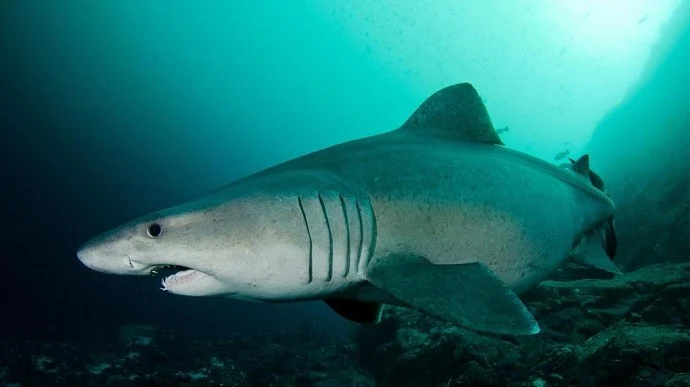New Research Indicates Higher Number of Warm-Bodied Sharks Than Previously Believed
New research arising from a collaboration between scientists at the University of Pretoria (UP) and Trinity College Dublin has shown there are likely more warm-bodied sharks out there than previously thought.
While most sharks have body temperatures equal to that of the water they’re swimming in, some sharks retain heat and thus maintain body temperatures several degrees above that of the water. These are warm-bodied sharks, or what scientists refer to as “regional endotherms” – “regional” because they only keep certain tissues warm, typically the red muscle used to power routine swimming. Some of the most famous sharks are warm bodied, like the great white shark. The enormous (and extinct) megatooth shark, which lurked the oceans around 10 million years ago, was believed to have been warm bodied too.
Keeping warm in cold water is very difficult. We might know the feeling from jumping into a pool and having the heat drawn from our bodies. For warm-bodied sharks, the challenge is even greater. That’s because all the blood pumped from the heart goes directly to the gills, where it comes into very close contact with the cold surrounding water, resulting in rapid heat loss. But warm-bodied sharks have a trick up their sleeve (or under their pectoral fin!) to keep the heat in and maintain elevated red muscle temperatures.
Dr Ned Snelling, an experimental physiologist from UP’s Faculty of Veterinary Science, explains: “Warm-bodied sharks have red muscle positioned toward the core of the body, which helps keep it warm by insulating it farther from the cold water. Perhaps more importantly, warm-bodied sharks also have a complex network of blood vessels that act as a ‘counter-current heat exchanger’, where cool blood arriving from the gills comes in close contact with warm blood draining from the muscle. As these two sources of blood run alongside each other, heat is exchanged across the vessel walls, so that by the time the cool blood reaches the red muscle, it is nearly as warm as the muscle itself! It’s a remarkable system because it allows heat to be retained internally at the site of production – the red muscle. Warm muscle functions better than cold muscle, and so it allows these sharks to remain active and mobile in low-temperature waters.”
The new research, involving Dr Snelling and shark scientists Drs Nicholas Payne and Haley Dolton from Trinity College Dublin, sheds light on this topic. It had always been thought that warm red muscle is a trait found only in top-level macropredators, such the great white shark or the extinct megatooth shark. In these sharks, warm red muscle enhances swim performance, enables faster cruising speeds, and allows these macropredators to remain active when feeding in cooler waters. The new research, published today in the Royal Society’s Biology Letters, now shows that at least two additional sharks are likely to have warm bodies. What makes the finding surprising is that these sharks are not top-level macropredators. Instead, the “smalltooth sand tiger shark” is a rather shy and elusive deep-water species found on the ocean bottom, where it feeds on smaller fish and invertebrates. And the “basking shark” is a slow-moving, filter-feeding, gentle giant of the ocean.
The researchers dissected smalltooth sand tiger sharks that had washed up on the coast of Ireland and the UK. Upon dissection, they found that these relatively ancient sharks have anatomical features consistent with known warm-bodied sharks, including red muscle positioned toward the core of the body, and a heart with very thick walls. This finding comes hot on the fins of their recent work that used body temperature loggers to show that the slow-moving, filter-feeding basking shark is also warm bodied.
Dr Snelling recalls a late-night phone call from his friend Dr Payne of Trinity College. “He rang to let me know that a unique opportunity had arisen to ‘look inside’ a rarely seen smalltooth sand tiger shark that had just washed up off the coast of Ireland. I’ve previously done some work on cardiac and skeletal physiology in different groups of animals, and so we thought the heart and locomotory muscle might be good spots to start digging! But we had to act fast, while the shark was still in good condition. The WhatsApp photos and videos were coming thick and fast as my collaborators meticulously took apart the beast.”
The first thing the team noticed, almost immediately, was that the red muscle was positioned toward the core of the shark. “This is something we really only see in warm-bodied sharks. The second, was that the heart had very thick walls, typically associated with higher-than-normal blood pressures and blood flows. We usually only see this type of heart in more active ‘high performance’ fishes, including those that have to support the high-energy requirements of having a warm body. I’m lucky to have such awesome collaborators, and together we were able to piece together that this elusive shark has many of the tell-tale signs of regional endothermy. But, there was one other big hint: the smalltooth sand tiger shark belongs to the same Order of sharks as other warm-bodied sharks, the so-called Lamniformes. If we can place a tiny body temperature logger in the animal, then it will confirm whether or not our suspicions are correct.”
Dr Payne, senior author of the study, said: “We think this is an important finding, because if smalltooth sand tiger sharks have regional endothermy, then it’s likely there are several other sharks out there that are also warm bodied… We used to think regional endothermy was confined to apex predators like the great white and extinct megalodon, but now we have evidence that deep water ‘bottom-dwelling’ smalltooth sand tigers, and plankton-eating basking sharks, also are warm bodied. This raises plenty of new questions as to why regional endothermy evolved, but it might also have important conservation implications.”

